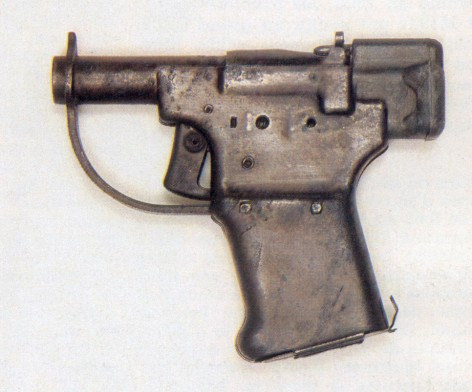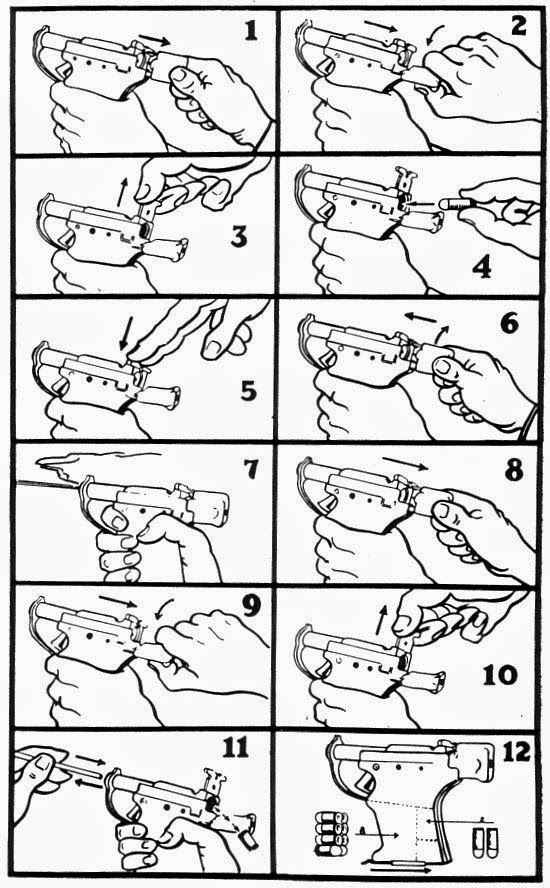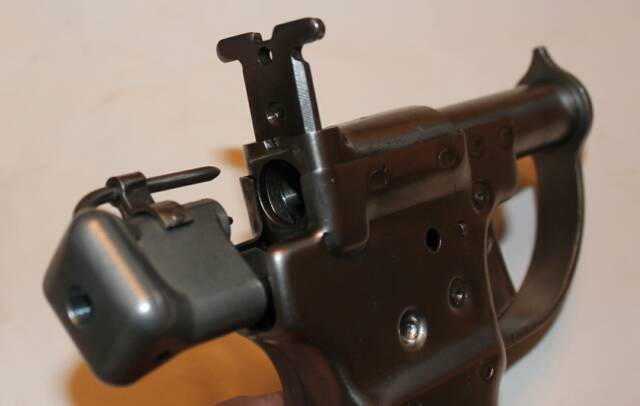It was crudely made from sheet metal and steel tube. It held only one shot at a time. According to some magazines, it took longer to load it than it did to manufacture it. But the Allies in World War II hoped that the Liberator Pistol would help defeat the Nazis. That said it was not solely made to defeat Nazis
Liberator Pistol
Liberator Pistol History

By 1940, Nazi forces had overrun nearly all of Europe. Britain itself faced invasion across the Channel and was short of troops and weapons. In desperation, the British military designed a crude sub-machine gun, known as the Sten, that could be manufactured quickly and cheaply from stamped parts and steel tubes. The gun was manufactured by the thousands and was widely distributed to be used in the defense of the island.
As it turned out, the Nazis lost the air Battle of Britain and their planned invasion never happened.
In 1942, a Polish military officer had an idea, inspired by the Sten--why not produce a cheaply stamped pistol that could be easily produced in large numbers and dropped behind the enemy lines to arm the various Resistance networks that had been formed in the occupied territories?
The idea appealed to some officers in the American Joint Psychological Committee, in charge of psychological warfare. They concluded that not only would a mass drop of thousands of weapons be of practical use in arming the Resistance fighters, but it would also hurt German morale by making the occupation troops fearful. They assigned the task to a team lead by George Hyde from the Inland Manufacturing Division of General Motors, and within a few weeks he had produced a design for a crude single-shot pistol dubbed the FP-45 Liberator.
Disguising the project as a flare projector (FP) to hide it from Nazi spies, the gun was deliberately designed to be as cheap and easily made as possible. There were only 23 parts: the barrel was a simple four-inch unrifled steel tube, and the rest of the gun was made from stamped pieces of sheet metal. It used the same .45 caliber ammunition as the Colt .45 automatic pistol. Each Liberator cost about $2.10 to make (about $35 in today's dollars). Some wags dubbed it the "Two-Buck Gun", or the "Woolworth Gun", after the five-and-dime store.
To load the weapon, the user had to twist the breech-block at the back of the pistol open and insert a single .45-caliber cartridge into the firing chamber, then close the block. Squeezing the sheet-metal trigger fired the pistol. After firing, the pistol could be reloaded by opening the block, pulling out the spent cartridge case (it often wouldn't come out, so the pistol came with a wooden dowel that was poked down the barrel to push the cartridge case out the back), inserting a fresh cartridge, and closing the block again. Testing done with the prototypes showed that the welded seams would often start splitting after just 10 rounds had been fired through the gun--and none of the tested pistols were still usable after 50 rounds. In humid conditions such as the Pacific islands, the unfinished metal in the guns often rusted and corroded within a few weeks.
But the Liberator was not intended as a combat weapon: rather, it was intended to be single-use and disposable. The idea was that a Resistance fighter could hide the Liberator in his pocket, walk up to an unsuspecting German trooper, pull the pistol and shoot him at close range, and then take his weapons and ammunition. The unrifled barrel gave the Liberator an effective range of fewer than ten feet, and the big .45 caliber cartridge was chosen because it was likely to kill or disable its target with just one shot.
Because the Inland Division was already busy producing M-1 rifles for the Army, the manufacture of the Liberator pistol was assigned to the Guide Lamp Division in Anderson, Illinois, a division of General Motors which in peacetime had been making automobile headlights and turn signals. About 300 GM workers were assigned to the task, and over a period of 11 weeks, they produced over a million Liberators. The finished pistols were packed in waxed-cardboard boxes with ten rounds of .45 caliber ammunition (which could be stored inside a hollow compartment in the pistol grip), a wooden dowel (for reloading), and a cartoon-illustrated instruction sheet showing how to load and use it (because the cartoon did not use verbal instructions, it could be dropped anywhere for any language group). The entire process, from design to manufacture, had taken about six months. Each gun had taken an average of 6.6 seconds to make.
Once manufactured, the Army, under both General Eisenhower and General MacArthur, declared that they saw no use for them, and the Liberators were turned over to the Office of Strategic Services (OSS), the American forerunner of the CIA which was in charge of Resistance activities in the occupied territories. Unlike the Army Psychological Warfare guys, however, the OSS never saw any real practicality in the weapon either, and never made any large-scale effort to distribute it to Resistance fighters, though about 100,000 Liberators were sent to guerrilla forces fighting the Japanese in the Philippines and China. Only about 25,000 pistols were dropped to Resistance groups in Europe. There are no documented instances of any Japanese or Nazi occupation trooper actually being killed by a Resistance fighter or guerrilla armed with a Liberator pistol. Most Resistance forces were supplied with the more-effective Sten instead.
At the end of the war, most of the Liberators sat unused in their boxes. To save storage space, they were ordered destroyed. As a result, today authentic Liberators are very rare and are highly prized by military collectors. A WW2 Liberator in good condition (and with the rare original box and equipment) can sell for over $2000.
Although the Liberator was not exactly a military success, during the Vietnam War in the 1960's the CIA resurrected the idea, and produced another single-shot disposable pistol called the "Deer Gun", intended to be dropped in behind enemy areas. The Deer Gun was made from cast aluminum with a short steel barrel and fired the 9mm Parabellum cartridge. It was loaded by unscrewing the barrel, inserting the cartridge, then screwing the barrel back on. About 1,000 Deer Guns were made in 1964, at a cost of about $3.95 each. After some field testing, it was never mass-produced, and the originals were destroyed.


The Liberator pistol has to rank as one of the most unusual firearms ever designed. First conceived as a way to equip resistance forces in World War II, today most reside behind glass at museums or in the hands of collectors. Fame ultimately escaped it, but it’s safe to say it served its purpose despite no records existing of it ever being used, mainly because the recipients were too busy moving, or fighting to stay alive.

Its concept began in March 1942, when a Polish military attaché suggested a simple, effective pistol that could be mass-produced and air -dropped by the hundreds or thousands in to waiting insurgents. The thought was that so many weapons delivered at once could instantly arm practically everybody in a local guerrilla group. Plus, it would do wonders for morale if everybody carried a weapon, and it would have a detrimental effect on occupying troops who might be led to believe that there was now a way for populations to massively resist them.
The U.S. Army’s Joint Psychological Warfare Committee accepted the proposal, and two months later George Hyde of General Motors Inland Manufacturing Division produced a design that met the specifications. To ensure its secrecy, it was given the designation Flare Projector-45 to conceal its real function.
GM’s Guide Lamp division was assigned the contract, and in 11 weeks with 300 workers, they assembled a million guns. Those who looked at the contraption had to imagine these were some sort of last-ditch device intended for one-time use. They were right.
Intended for people who may not be familiar with firearms, the Liberator was simplicity in itself. Of 45 caliber, 5.5 inches long and weighing one pound, it featured 23 stamped steel parts for a total cost of $2.40 per gun. Five rounds could be stored in the grip, which did not feed into the barrel. To do this, one manually inserted a .45 caliber cartridge at the rear, and then the chamber was hand-closed by a metal part. The round was then shot down a 4-inch, un-rifled barrel for an effective range of 25 feet. To clear the empty case, a wooden dowel was supplied to push it out the back and another round could be loaded.
In reality, the range was wishful thinking. This gun was intended to be placed the person that is to be killed so their weapon could be taken. It could then be discarded, passed on or saved for a final stand.
FP-45 Model 2 Right-rear view of the open action
Liberators were packed in boxes that included 10 rounds of .45 ammunition, the wooden dowel, and a comic strip type instruction sheet. A million shipped off to both Great Britain and the Pacific, where they were stored and ready to be loaded into containers on aircraft. There they met their greatest obstacles, the General Staffs of the United States Army.
In Europe, Eisenhower’s men saw no practical purpose for the gun and only 25,000 were dropped to the French resistance. In the Pacific, MacArthur was also sour about the idea and the Army ended up turning the remaining lot over to the Office of Strategic Service to be dropped in both theaters when necessary.
Enhanced FP-45 Liberator Study Model 1
Small drops commenced in 1943 over Europe, while that same year 100,000 ended up being sent to China and smaller numbers dropped in the Philippines. In 1944, another European drop occurred in Greece to supply a few thousand to the resistance. By this time, it had a nickname derived from its cheap looks: The ‘Woolworth’ Gun.
How many were actually used will never be known, but it is safe to say some Axis soldiers met their end with the Liberator, as well as having their weapon stolen. There was never an attempt to round them up after the war, figuring most had been thrown away by then. Those that remained, the still hundreds of thousands of unused copies in warehouses, were melted down. Today, the Liberator is written about sparingly as its success is unknown. Its new life is that of a collectible, with excellent specimens in original box complete with accessories fetching up to $2,000 or more.
Inland Guide Lamp Liberator .45 ACP caliber pistol. Made by Inland Guide Lamp manufacturing. Over 1 million of these were made in a 3 month period. These were used as an insurgency weapon during WWII and most of these were distributed to the Philippines. Despite the fact that a million were made there are not too many in the USA as the only ones that made it back were from the GI’S.
U.S. FP-45 Liberator Pistol, manufactured by G.M. Guide Lamp Division, serial # None, cal. 45 ACP, 4" barrel with an excellent bore. The barrel has a smooth grind mark with an "F "inside a" C" stamp on the right side front of the chamber. The metal surfaces are gunmetal gray retaining about 99% original corrosion resistant finish with scattered light handling marks and minor freckling. The cocking knob is in excellent condition with cavity mold number 37. This fully functional model three pistol that has three holes, no breach marking, floor plate is present. The overall condition is it’s in Collectors Grade Condition. {C&R} Inv.: # 1-1301
![]()
POLICE INFORMATION
Copies of: Your Baltimore Police Department Class Photo, Pictures of our Officers, Vehicles, Equipment, Newspaper Articles relating to our department and or officers, Old Departmental Newsletters, Lookouts, Wanted Posters, and or Brochures. Information on Deceased Officers and anything that may help Preserve the History and Proud Traditions of this agency. Please contact Retired Detective Kenny Driscoll.

NOTICE
How to Dispose of Old Police Items
Please contact Det. Ret. Kenny Driscoll if you have any pictures of you or your family members and wish them remembered here on this tribute site to Honor the fine men and women who have served with Honor and Distinction at the Baltimore Police Department.
Anyone with information, photographs, memorabilia, or other "Baltimore City Police" items can contact Ret. Det. Kenny Driscoll at
Copyright © 2002 Baltimore City Police History - Ret Det Kenny Driscoll






